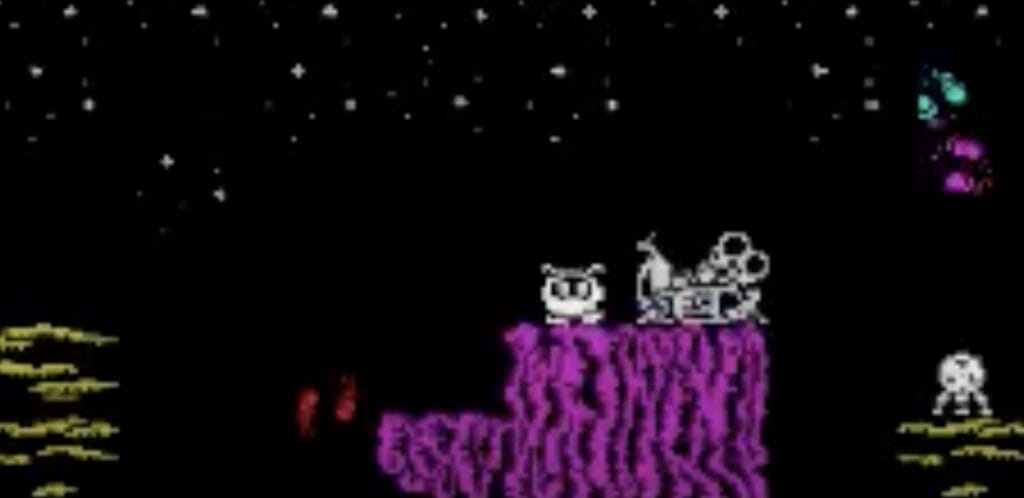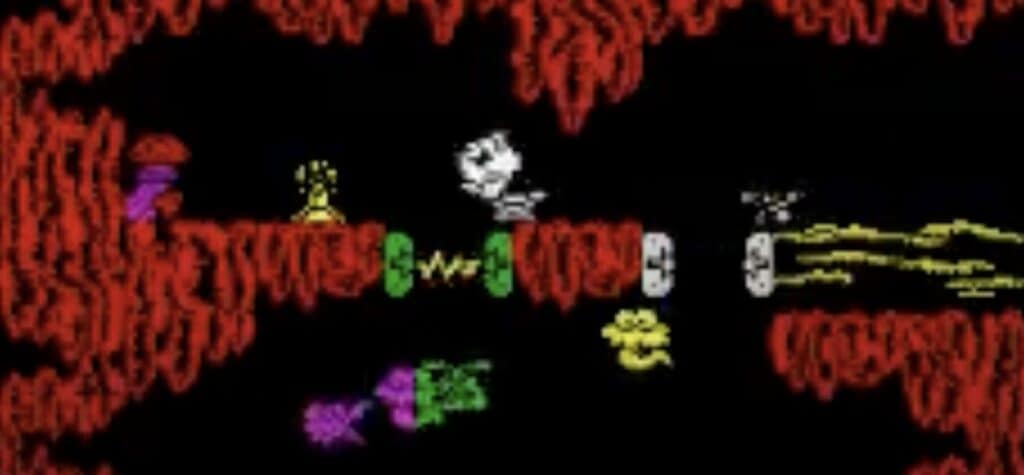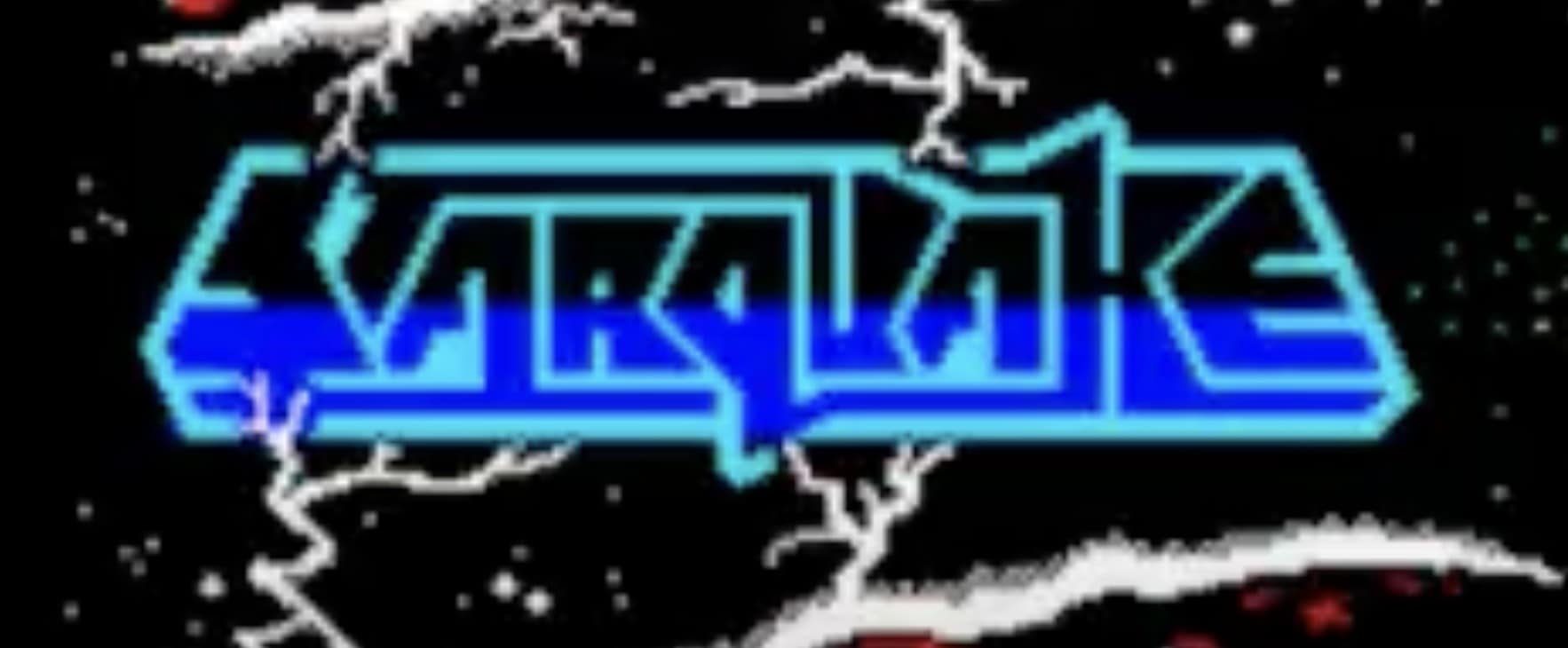Starquake is a 1985 action-adventure platform game originally released for the ZX Spectrum. Stephen Crow was the lead writer, designer, and programmer for the game. Bubble Bus Software developed and published Starquake’s original release and helped port the game to other consoles. After the 1985 ZX Spectrum release, Starquake was also released on the Commodore 64, MSX, Amstrad CPC, Atari 8-bit family, and Tatung Einstein later that same year. In 1987, it got a BBC Micro port. IBM compatibles and the Atari ST were some of the last consoles to receive a port in 1988.
Today, gamers can find various free versions of Starquake just by Googling the game. My Abandonware has a 1988 DOS version available to download and the same version available online. ClassicReload.com also has the DOS version, which can be played right on an internet browser. ClassicReload doesn’t require any downloads and it has a huge library of retro games, making it a great resource for curious gamers. The website’s game library includes other classic games like TNK III and The Rocky Horror Show. There are a few other websites that have Starquake for free. Players should look into their options to make sure they are comfortable with whatever source they end up choosing.
At the time of Starquake’s release, the game received a lot of attention and praise from gamers and critics. Your Sinclair (YS), a popular British computer magazine of the time, ranked Starquake #27 out of 100 on its “Official Top 100 Games of All Time” list. Retro Gamer magazine, a current popular British gaming magazine, ranks Starquake at #10 out of 25 on its “Top 25: Spectrum Games” list. Modern gamers still love this ZX Spectrum classic. My Abandonware rates Starquake a 4.4 out of 5 and ClassicReload gives it the same rating. 96% of Google users who weighed in about the game claim to like it.
Starquake Premise
Gaming throughout the 1980s and ’90s was very different from what it’s like today. Games featured simplistic gameplay that often had little to no story. In the ’80s especially, when gaming technology was still growing past the arcade’s limitations, games didn’t include lengthy cutscenes or complicated stories, and sometimes, they didn’t even have protagonists. Many games, like TNK III and Gradius, didn’t feature playable characters. Instead, players took control of a vehicle, high-tech suit or armor, or some other vessel that was not a living creature.
When taking all of this information into perspective, Starquake stood out among its competition. Not only does Starquake actually have a playable main character (MC), but it also has a solid, albeit simple plot. Players play as BLOB (which stands for Bio-Logically Operated Being). BLOB is sent on an important mission to investigate an unstable rogue planet that popped out of a black hole. BLOB needs to penetrate the planet’s core and repair it before the planet implodes. If the planet implodes so close to the black hole, it will most likely set off a chain reaction that will destroy everything.
With the weight of the universe on their shoulders, players feel the urgency to repair to core before the time runs out. The gameplay might be basic to modern gamers, but the game has a set goal in place. This gives purpose to the game’s overarching narrative. Players aren’t just mindlessly exploring or engaging in combat.
For the time, Starquake’s gameplay was unique, impactful, and more complex than other games of a similar nature. BLOB needed to traverse the rogue planet, where they would encounter hazardous primitive enemies that BLOB couldn’t touch. There are also obstacles and traps like spikes and energy fields that will kill BLOB instantly. BLOB also navigates through ancient civilization ruins to collect resources to stabilize the core. Players need to keep track of a lot while playing Starquake. Starquake works on a points system, meaning every positive action the player completes adds to their score. Defeated enemies are worth 80 and 320 points each. Players earn 10,000 points for every core item replacement. Every time BLOB moves to a new screen (a new area), the player earns another 250 points.
In total, Starquake features 512 different screens that players can visit and play on. For the time, that is a lot of diversity in locations and areas to explore. Players need to replace nine core elements to win. At the beginning of each game, the placement of these items is completely randomized, making each playthrough a unique experience.
Starquake Main Characters

©Channel moved to “The Andy Godoy Show” / Stephen Crow / Bubble Bus Software – License
Starquake only features one main character and that’s the playable protagonist, BLOB (Bio-Logically Operated Being). BLOB is sent to a rogue planet that just emerged from a black hole with one goal in mind: Stop the planet from imploding. If BLOB fails to get to the planet’s core and stabilize it from within, the planet will set off a chain reaction that will destroy the universe. To stabilize the core, BLOB needs to collect and replace nine core pieces.
In comparison to other platformer games of the time, BLOB’s mechanics were quite complex. BLOB has multiple ways to get around:
- Running is the most common movement.
- BLOB can use hover platforms to fly, but they will be unable to pick up items while on a hover platform.
- To board a hover platform, BLOB needs to find a docking station.
- BLOB can build temporary platforms to reach high areas.
- BLOB can drop temporary platforms on traps and obstacles to break them.
- BLOB can enter transportation tubes that act as elevators, but BLOB cannot enter these if they are already on a hover platform.
- Players can take advantage of teleportation booths set up around the planet. Each will take the player to a specific place on the map.
- There are secret passageways hidden around the map that provide BLOB with shortcuts.
BLOB uses a first-in, first-out (FIFO) system to carry up to four items. Carriable items include core repair pieces, an Access Card that will fill out with various access chips to get through security doors, and items that need to be traded or swapped for something more valuable. BLOB will also be able to collect items that will refill energy, platform building, or firepower. The item will automatically replenish the slot with the lowest reserves. BLOB can also collect joysticks for extra lives.
With such advanced mechanics for the mid-’80s, it’s no surprise that BLOB made history. Many of these mechanics are featured in more modern platformers. Super Mario Bros. and Sonic the Hedgehog both use many of these mechanics.
Starquake Titles in the Series
Despite Starquake’s success, it didn’t spawn a franchise or even a sequel. Stephen Crow, Starquake’s writer, programmer, and designer did begin work on a sequel called Starquake II, but it never saw the light of day. Mark R. Jones, another video game designer, allegedly found Crow’s work on Starquake II in 2014. While sorting disk archives, Jones found some files for Starquake II that were going to be released through Ocean, the company Jones worked for. The original Starquake II work dates back to 1992. Jones had access to them because he was working on the graphics for the unfinished project at the time. The game was never published, but curious parties can find the preserved version on Atarimania.
Starquake Cheats, Passwords, and Level Selection

©Channel moved to “The Andy Godoy Show” / Stephen Crow / Bubble Bus Software – License
The 1980s and ’90s video games were synonymous with cheat codes or other ways to “cheat” and make the game easier. This is because, at the time, games were fast-paced and needed to be completed in a single sitting. Players either won, ran out of lives, or failed their objective, resulting in a Game Over. Most games didn’t have checkpoints to restart at and even if they did, receiving a Game Over would erase the checkpoint. The player’s gameplay also depended on their ability to get power-ups, extra lives, and other helpful items that would make the challenge of the higher levels easier to digest.
To complete most games authentically, players needed to be dedicated to playing, losing, restarting, getting better, and losing again. Eventually, they would sharpen their skills enough that they might be able to master the game and finally beat it. Making these games incredibly challenging to beat was part of the replayability. Sometimes, without cheats, players had little hope of actually getting to the end of the game. Fortunately, developers understood how annoying this could be, so they often built cheat codes straight into their games. These cheats sometimes resulted in game-breaking effects, like immortality, infinite lives, or more powerful weaponry.
Fortunately, Starquake does have some useful codes. Unfortunately, these codes are teleporter codes and/or level selections. These are useful codes because players can easily get back to where they lost their last game, but they objectively aren’t as cool as immortality or overpowered weapons.
It’s important to keep in mind that Starquake came out almost 40 years ago. These codes only work with specific versions of the game and there’s no guarantee that they’ll work on modern ports. As long as players are using the correct codes that correspond with their version, the codes should work. It’s still worth noting they may not work, though.
Amstrad CPC Teleporter Codes
- Teleport to AMBOR: AMBOR
- Teleport to ANGLE: ANGLE
- Teleport to ASCIO: ASCIO
- Teleport to DULON: DULON
- Teleport to ELIXA: ELIXA
- Teleport to INDOL: INDOL
- Teleport to KRYZL: KRYZL
- Teleport to OPTIK: OPTIK
- Teleport to QUORE: QUORE
- Teleport to RALIQ: RALIQ
- Teleport to SNODY: SNODY
- Teleport to TALIS: TALIS
- Teleport to UPAZZ: UPAZZ
- Teleport to VOREX: VOREX
- Teleport to ZODIA: ZODIA
Atari 8-Bit Teleporter Codes
- Teleport to a different area: TRAID
- Teleport to a different area: ARTIC
- Teleport to a different area: DELTA
- Teleport to a different area: KERNX
- Teleport to a different area: ARGON
- Teleport to a different area: QUARK
- Teleport to a different area: WHOLE
- Teleport to a different area: SALCO
- Teleport to a different area: ATARI
- Teleport to a different area: PENTA
- Teleport to a different area: CRASH
- Teleport to a different area: Z.A.P
- Teleport to a different area: MINIM
- Teleport to a different area: SECON
- Teleport to a different area: COSEC
Atari ST Teleporter Codes
- Teleport to a different area: TABET
- Teleport to a different area: HINDI
- Teleport to a different area: KWANG
- Teleport to a different area: ROKEA
- Teleport to a different area: SOLUN
- Teleport to a different area: CWORE
- Teleport to a different area: KALED
- Teleport to a different area: DAVRO
- Teleport to a different area: BORNO
- Teleport to a different area: TSOIN
- Teleport to a different area: FLIED
- Teleport to a different area: NICHA
- Teleport to a different area: LUANG
- Teleport to a different area: CHING
- Teleport to a different area: SOCHI
BBC Micro Teleporter Codes
- Teleport to ARLON: ARLON
- Teleport to ASOGE: ASOGE
- Teleport to DARAQ: DARAQ
- Teleport to HARIA: HARIA
- Teleport to KOPEX: KOPEX
- Teleport to LEXIA: LEXIA
- Teleport to MISES: MISES
- Teleport to OKRIP: OKRIP
- Teleport to OTRUN: OTRUN
- Teleport to QUARK: QUARK
- Teleport to ROGAL: ROGAL
- Teleport to SAMAL: SAMAL
- Teleport to TAMIS: TAMIS
- Teleport to URIAH: URIAH
- Teleport to VILGA: VILGA
Commodore 64 Level Selection
- Level 1: ASTRA
- Level 2: COSIN
- Level 3: CHASM
- Level 4: KAPPA
- Level 5: METRE
- Level 6: PLASM
- Level 7: POLAR
- Level 8: SIGMA
MSX Teleporter Codes
- Teleport to ANGOR: ANGOR
- Teleport to ANTIO: ANTIO
- Teleport to ARGOL: ARGOL
- Teleport to DULAN: DULAN
- Teleport to ERCOT: ERCOT
- Teleport to INDLE: INDLE
- Teleport to KRANZ: KRANZ
- Teleport to KWAKE: KWAKE
- Teleport to OPTIN: OPTIN
- Teleport to RAZON: RAZON
- Teleport to SNOOL: SNOOL
- Teleport to TARAG: TARAG
- Teleport to UPLAN: UPLAN
- Teleport to VORAX: VORAX
- Teleport to ZODIA: ZODIA
PC Teleporter Codes
- Teleport to ABYSS: ABYSS
- Teleport to BAGEL: BAGEL
- Teleport to CLOUD: CLOUD
- Teleport to HIDEE: HIDEE
- Teleport to KYANG: KYANG
- Teleport to LIMMA: LIMMA
- Teleport to LOUSE: LOUSE
- Teleport to MOIST: MOIST
- Teleport to MORIA: MORIA
- Teleport to NUGAE: NUGAE
- Teleport to PULSE: PULSE
- Teleport to QUAND: QUAND
- Teleport to RAPID: RAPID
- Teleport to RUBIA: RUBIA
- Teleport to WATER: WATER
Sinclair ZX81/Spectrum Teleporter Codes
- Teleport to a different area: VEROX
- Teleport to a different area: RAMIX
- Teleport to a different area: ULTRA
- Teleport to a different area: SONIQ
- Teleport to a different area: AMAHA
- Teleport to a different area: AMIGA
- Teleport to a different area: ASOIC
- Teleport to a different area: ALGOL
- Teleport to a different area: EXIAL
- Teleport to a different area: IRAGE
- Teleport to a different area: TULSA
- Teleport to a different area: DELTA
- Teleport to a different area: KYZIA
- Teleport to a different area: OKTUP
- Teleport to a different area: QUAKE
- This teleporter code is the one that spits the player out closest to the planet’s core
Starquake Cheats FAQs
If players Google “Starquake video game cheats”, there are no frequently asked question results. Googling “Starquake video game” also turns up no FAQ results.
The image featured at the top of this post is ©Channel moved to “The Andy Godoy Show” / Stephen Crow / Bubble Bus Software.
